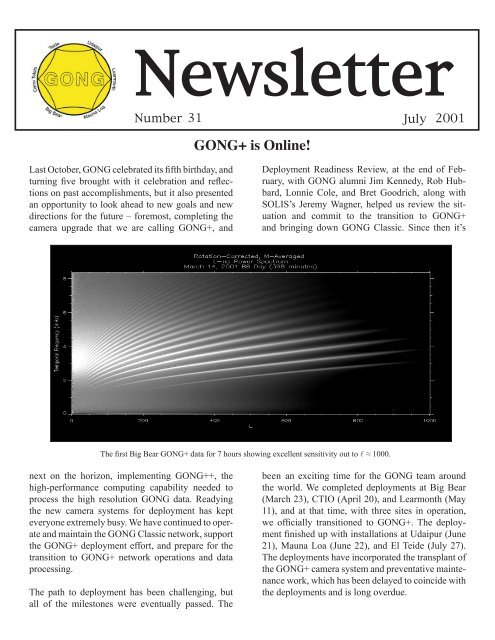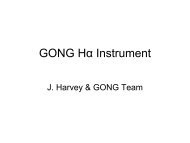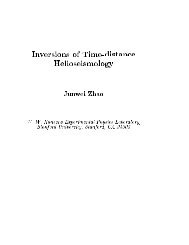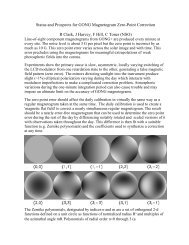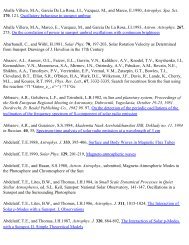GONG Newsletter #31, August - National Solar Observatory
GONG Newsletter #31, August - National Solar Observatory
GONG Newsletter #31, August - National Solar Observatory
Create successful ePaper yourself
Turn your PDF publications into a flip-book with our unique Google optimized e-Paper software.
<strong>Newsletter</strong><br />
Number 31 July 2001<br />
<strong>GONG</strong>+ is Online!<br />
Last October, <strong>GONG</strong> celebrated its fth birthday, and<br />
turning ve brought with it celebration and reections<br />
on past accomplishments, but it also presented<br />
an opportunity to look ahead to new goals and new<br />
directions for the future – foremost, completing the<br />
camera upgrade that we are calling <strong>GONG</strong>+, and<br />
Deployment Readiness Review, at the end of February,<br />
with <strong>GONG</strong> alumni Jim Kennedy, Rob Hubbard,<br />
Lonnie Cole, and Bret Goodrich, along with<br />
SOLIS’s Jeremy Wagner, helped us review the situation<br />
and commit to the transition to <strong>GONG</strong>+<br />
and bringing down <strong>GONG</strong> Classic. Since then it’s<br />
The rst Big Bear <strong>GONG</strong>+ data for 7 hours showing excellent sensitivity out to l ≈ 1000.<br />
next on the horizon, implementing <strong>GONG</strong>++, the<br />
high-performance computing capability needed to<br />
process the high resolution <strong>GONG</strong> data. Readying<br />
the new camera systems for deployment has kept<br />
everyone extremely busy. We have continued to operate<br />
and maintain the <strong>GONG</strong> Classic network, support<br />
the <strong>GONG</strong>+ deployment effort, and prepare for the<br />
transition to <strong>GONG</strong>+ network operations and data<br />
processing.<br />
The path to deployment has been challenging, but<br />
all of the milestones were eventually passed. The<br />
been an exciting time for the <strong>GONG</strong> team around<br />
the world. We completed deployments at Big Bear<br />
(March 23), CTIO (April 20), and Learmonth (May<br />
11), and at that time, with three sites in operation,<br />
we ofcially transitioned to <strong>GONG</strong>+. The deployment<br />
nished up with installations at Udaipur (June<br />
21), Mauna Loa (June 22), and El Teide (July 27).<br />
The deployments have incorporated the transplant of<br />
the <strong>GONG</strong>+ camera system and preventative maintenance<br />
work, which has been delayed to coincide with<br />
the deployments and is long overdue.
Hats off to our deployment<br />
teams – they have done a lot<br />
of traveling in the last ve<br />
months and have done a great<br />
job.<br />
The Project has had some<br />
comings and goings in the<br />
<strong>GONG</strong> team here in Tucson.<br />
Susan Davidson, who was<br />
with <strong>GONG</strong> for over six<br />
years, and NOAO for nearly<br />
25 years, retired at the beginning<br />
of February. She will be<br />
missed throughout the <strong>GONG</strong> <strong>GONG</strong>+ Instrument Team members (from left to right):<br />
community, and we wish her Jean Goodrich, Roberta Toussaint, Roy Tucker,<br />
the very best in the future. Sang Nguyen, Guillermo Montijo, Lana Britanik,<br />
Bert Villegas, Ron Kroll, and Jack Harvey<br />
Roberta Toussaint, who has<br />
been with <strong>GONG</strong> for nearly a decade, has moved<br />
over to NSO’s SOLIS Project. We look forward to<br />
her continued association with <strong>GONG</strong>, which has<br />
included her participation in the <strong>GONG</strong>+ deployment.<br />
We also saw Tatia Wing move on and wish her<br />
the best in her new adventures. David Landy will<br />
be leaving at the end of the summer and setting new<br />
goals as a graduate student at Indiana University.<br />
in the production and deployment<br />
of <strong>GONG</strong> Classic, and<br />
it is great to have him back<br />
on the team. Katrina Gressett,<br />
Simon Kras and Kerri Donaldson<br />
Hanna joined the DMAC<br />
group, and Jeffrey Sudol will<br />
be working with the Instrument<br />
Team.<br />
Kiran Jain, from the Udaipur<br />
<strong>Solar</strong> <strong>Observatory</strong>, visited<br />
Tucson in February and March<br />
of this year, and was one of the<br />
rst <strong>GONG</strong>+ users, producing<br />
ring diagrams in both velocity<br />
and intensity.<br />
On the positive side of the ledger, Caroline Barban<br />
joined the Analysis Group and is working on improving<br />
the mode parameter estimates by simultaneously<br />
tting the spectrum obtained in velocity and intensity.<br />
Guillermo Montijo was welcomed back into the<br />
fold. As many of you remember, he was a key player<br />
A cut through 3-dimensional power spectra at 3.5 mHz for the<br />
velocity (left panel) and intensity (right panel). The spectra<br />
were generated by tracking a 20° by 20° region for 2 days as it<br />
crossed disk center. Each gure extends ± 2.2 Mm -1 k x<br />
and k y<br />
.<br />
<strong>GONG</strong>-SOHO 2002<br />
Big Bear <strong>Solar</strong> <strong>Observatory</strong> - October 2002<br />
Final dates and meeting information to follow via email, snail mail, and the<br />
<strong>GONG</strong> www server.<br />
The <strong>GONG</strong> bibliography is being integrated into the Astrophysics Data System at<br />
http://adsabs.harvard.edu/Groups/search/Helioseismology or on the main ADS search<br />
form. Keep your pre/reprints coming.
What Data Can I Get from <strong>GONG</strong><br />
<strong>GONG</strong> provides data freely to its members. Becoming<br />
a member is simple — go to the <strong>GONG</strong> web page<br />
and select the “Scientic Enterprise” link and then the<br />
“<strong>GONG</strong> Membership Application” link and then the<br />
“<strong>GONG</strong> Research Program Application” link. You can ll<br />
out the forms electronically, or by using a text le. After<br />
the forms are submitted and processed, you will be able to<br />
search and order our data.<br />
Some of the currently available products for the helioseismologist<br />
are:<br />
Power spectra of solar oscillations covering the range of<br />
0 ≤ l ≤ 200, -l ≤ m ≤ +l, and 0 ≤ ν ≤ 8.33 mHz.<br />
Time series of complex spherical harmonic coefcients as<br />
a function of l and m in the range 0 ≤ l ≤ 200 and 0 ≤ |m|<br />
≤ l.<br />
Estimated frequencies, amplitudes, and linewidths of solar<br />
oscillation modes, as a function of l, m, and ν covering<br />
the range 0 ≤ l ≤ 150, -l ≤ m ≤ +l, and 1.2 ≤ ν ≤ 4.0<br />
mHz.<br />
Both the time series and power spectra are available for temporal<br />
intervals of <strong>GONG</strong> months (GM), with 1 GM ≡ 36<br />
days. Note, however, that the mode parameters are computed<br />
from overlapping three-GM (108 day) temporal<br />
intervals, with a one-GM spacing. Time series and power<br />
spectra are also available for 0 ≤ l ≤ 45 for intervals of 1<br />
<strong>GONG</strong> Year (10 GM or 360 days) and 35 GM. All data<br />
from 7 May 1995 to 6 October 2000 have been processed<br />
to time series and power spectra, and the mode parameters<br />
have been computed on all possible 53 intervals of 3 GM.<br />
For the non-helioseismologist, we have:<br />
• Minute-by-minute images of the solar surface Doppler<br />
velocity eld from 7 May 1995 to the present.<br />
• Magnetograms every 20 minutes, plus derived synoptic<br />
maps for Carrington rotation cycles 1896 through<br />
1942; and<br />
• Low-pass, temporally ltered, and geometrically registered<br />
images of the surface Doppler velocity with a<br />
cadence of 4 minutes and a lter width of 17 minutes,<br />
useful for studies of slowly evolving ows from 7 May<br />
1995 to 17 October 1998.<br />
Finally, we have implemented a new data service that provides<br />
near-real-time magnetograms with rough calibration<br />
and a cadence of about one every two hours around the<br />
clock. They can now be obtained at:<br />
ftp://www.gong.noao.edu/pub/gong/magnetograms<br />
Sasha Kosovichev called attention to changes in <strong>GONG</strong>+ observations of the X20 are of April 2, 2001 in NOAA 9393, and<br />
Jack Harvey prepared this gure to show the temporal evolution. The left panel is the line-of-sight component of the magnetic<br />
eld near the northeast limb averaged over 30 minutes prior to the are (2100-2129 UT). The next six panels show the difference<br />
between the absolute value of the signal averaged over subsequent ten minute periods and the 30 minute pre-are average. White<br />
(black) represents increasing (decreasing) line-of-sight signal strength. The panels are averaged from left to right over 2130-39<br />
(preare), 2140-49 (rising phase), 2150-59 (maximum), 2200-09 and 2210-2219 (declining phase), and 2250-59 (post are). The<br />
changes shown are a combination of seeing effects, change in perspective as the Sun rotates, line prole changes associated with<br />
the maximum phase of the are, normal evolution of the active region eld, and real eld changes associated with the are. The<br />
later panels are coincident with a strongly sheared sunspot. It is not clear if the are eld changes are in strength, direction or<br />
position or some combination.
Site Focus ... Mauna Loa <strong>Solar</strong> <strong>Observatory</strong><br />
Mauna Loa <strong>Solar</strong> <strong>Observatory</strong> (MLSO) is operated by the High Altitude<br />
<strong>Observatory</strong> (HAO), a division of the <strong>National</strong> Center for Atmospheric<br />
Research and funded by the <strong>National</strong> Science Foundation. The observatory is<br />
located at an elevation of 3,400 meters (11,000 feet) on the north slope of<br />
Mauna Loa which is an active shield volcano rising 4,200 meters (13,800<br />
feet) above sea level on the Island of Hawaii. The Mauna Loa site was<br />
chosen for its unique properties that include a mountain thousands of kilometers<br />
away from any continental land mass, young lava, and lack of<br />
nearby vegetation. These factors keep local particulate contamination to a<br />
minimum and provide the clean, dry air and dark skies necessary for exceptional<br />
coronal measurements. MLSO operates an assortment of instruments<br />
built by HAO and the NSO that observe the solar corona, chromosphere, photosphere,<br />
and solar interior. HAO is dedicated to the study of the Sun and of the<br />
response of the Earth’s upper atmosphere to the Sun’s output. As a nationally<br />
sponsored laboratory, HAO is committed to the dissemination of its data to the<br />
community at large.<br />
Data collected include: solar oscillations by <strong>GONG</strong> and ECHO, used to determine solar interior rotation rates and structure; photometry<br />
of the chromosphere and photosphere by PSPT (NSO) to study solar variability; chromospheric observations in Hα by PICS and Helium<br />
1083 nm by CHIP; MK4 electron density images of the corona. PICS, CHIP and MK4 are used to study solar activity including coronal<br />
mass ejections and long-term solar cycle variability. Movies and images of present and past data are available via the internet at:<br />
http://mlso.hao.ucar.edu.<br />
MLSO and <strong>GONG</strong> are guests on the <strong>National</strong> Oceanic and Atmospheric Administration’s (NOAA) Mauna Loa <strong>Observatory</strong> (MLO) site.<br />
(http://stratus.mlo.hawaii.gov.) MLO is a baseline station for NOAA’s Climate Monitoring and Diagnostics Laboratory (CMDL). CMDL<br />
conducts research related to atmospheric constituents such as gases, aerosols, solar radiation, meteorology, and precipitation chemistry that<br />
are capable of forcing change in the climate of the Earth’s environment. MLO also hosts cooperative programs with the Network for the<br />
Detection of Stratospheric Change and many other research institutions.<br />
<strong>GONG</strong>’s web site http://www.gong.noao.edu is up-to-date with<br />
Project status, scientific investigations and publications, access to<br />
data products, and links to other activities within the field of helioseismology.<br />
The FTP archives for <strong>GONG</strong> can be found at the anonymous FTP<br />
address: ftp://www.gong.noao.edu/pub/gong.<br />
The <strong>GONG</strong> <strong>Newsletter</strong> is also available on <strong>GONG</strong>’s web site as a<br />
WWW document and an easily printable PDF document. We encourage<br />
you to avail yourself of this service.<br />
You can be removed from the hardcopy mailing list, and added to<br />
the e-mail notification list, by simply sending an e-mail message to<br />
gong@noao.edu.<br />
The <strong>GONG</strong> Project is funded by the <strong>National</strong> Science Foundation (NSF) through the <strong>National</strong> <strong>Solar</strong> <strong>Observatory</strong> (NSO),<br />
which is operated under a cooperative agreement between the Association of Universities for Research in Astronomy (AURA), Inc. and NSF.<br />
The GLOBAL OSCILLATION NETWORK GROUP<br />
P.O. Box 26732<br />
Tucson, Arizona 85726-6732<br />
USA


